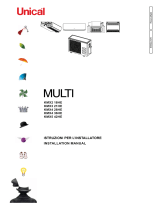
VAM 6 MWN-I_EN - 09/14 - Vaillant
9
• Make the holes using a drill and insert the rawl plugs.
• Place the mounting plate in position, level it horizontally
and fix it with the screws and the plugs.
b
WARNING!
Danger of breakdowns or malfunction.
• Ensure that the mounting plate has been cor-
rectly levelled. Otherwise, disassemble the
plate and assemble it again correctly. Failure
to do so could lead to water leaks.
9.3 Installation of the pipe work
9.3.1 Correct removal of condensate water
a
DANGER!
Danger of breakdowns or malfunction.
Danger of condensed water leakage.
• In order to ensure that the unit drains correctly
take the recommendations described in this
section into account.
Methods for the removal of the condensed water which is
generated in the indoor unit:
- Condensed water can be allowed to drain naturally using
the natural fall of the condensed water pipe to a suitable
drain point. In order for it to be aesthetically pleasing, use
a solid pipework or trunking to cover the pipework.
- Alternative hidden installation solutions also exist.
- For example, using an external pump for removal of the
condensed water, carrying the condensed water to outside
or to main drainage system.
- By natural fall to a collection point which is then emptied
using a pump which operates when the tank is full,
pumping the water to a suitable drain point.
b
WARNING!
Danger of breakdowns or malfunction.
Danger of condensed water leakage.
• To ensure that the unit drains properly using a
natural fall, the condensed water pipe must
have a an adequate fall from the indoor unit.
9.3.2 Handling the refrigerant pipes
a
DANGER!
Danger of burns and eye injuries.
• When brazing pipe lines, use suitable protec-
tion equipment (protective eye protection and
mask, welding gloves, flame proof clothing).
a
WARNING!
• Danger of breakdowns or malfunction. Danger
of damage to refrigerant pipes through the use
of unsuitable materials.
- Use only pipes specically intended for refrigeration and
R410A refrigerant.
- Ensure that the refrigerant pipes are clean, dry and
polished on the inside.
- The insulation of the pipes should be done using specic
class ‘O’ insulation for cooling.
- Observe the minimum and maximum pipe lengths for
each model.
- Wherever possible avoid install excessive numbers of
bends in pipes. Do not over bend the pipe, keep the
radius as big as possible to minimise load losses.
- When brazing pipes together, use only the correct brazing
materials. During the brazing process a stream of oxygen
free nitrogen should be run through the inside of the
pipes in order to avoid oxidisation forming inside the pipe
connection.
- Only cut the coolant pipes using propriety pipe cutters,
ensuring no swarf enters the pipe, and always keep the
pipe ends sealed wherever possible to avoid moisture
being allowed to enter the pipe.
- Any aring work should be performed meticulously in
order to create the correct connection and to avoid
subsequent gas leaks through the pipe connections.
- When reaming the cut pipe keep the pipe opening
directed downwards in order to prevent shavings from
getting into the pipes.
- Mount the joining tubes carefully, ensuring they cannot
become displaced during brazing. Ensure that there is no
strain on the pipe joints.
- Ensure that all pipework is insulated with the correct grade
of closed cell insulation and that all joints in the insulation
are sealed with insulation tape or glued.
- Carefully tighten the flaring connectors, centring the
flaring cone and the flanged nut. Applying excessive force
without correctly centring can damage the thread and may
allow water ingress into the connection.
9.3.3 Correct installation of the condensate pipe
work
b
WARNING!
Danger of breakdowns or malfunction.
• Danger of water leaks and blockages from
unit and pipework:
EN
INSTALLATION

























